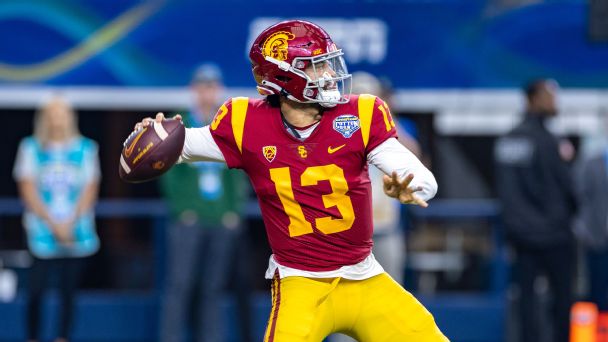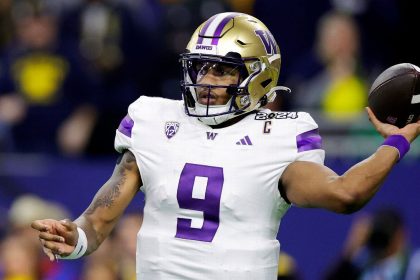
The 2023 NFL draft class saw a record 12 quarterbacks selected in the first five rounds, including three inside the top five picks. The 2024 class? Expect some similarities.
The quarterback group begins with an interesting battle between USC’s Caleb Williams and North Carolina’s Drake Maye at the top — similar to Bryce Young and C.J. Stroud‘s race to No. 1 in the 2023 class — with the QB3 spot completely up for grabs among a few other promising passers. But there’s also a lot of depth here. It’s early, but we could easily see double-digit QBs selected again next April. Transfers also dominate the 2024 class; I took a closer look at 26 quarterbacks here, and 21 of them spent time at another school.
So who are the top names to know in 2024? What are their strengths, and where do they need to improve? Let’s look at the 26 best passers who are draft-eligible next spring, from six first-round contenders to the potential steals on Days 2 and 3. I’ll also answer a few big questions about the QB class, including who could be the No. 1 overall pick and which NFL teams are in the hunt for a new franchise QB.
Jump to:
Top QBs to know | Best of the rest
Big questions for the class

TOP NAMES TO KNOW
![]()
Height: 6-foot-1 | Weight: 220 pounds
Class: Junior
Where he excels: Williams followed coach Lincoln Riley to USC from Oklahoma and blossomed during his Heisman Trophy-winning sophomore season, throwing for 4,537 yards and 42 touchdowns with five interceptions. He added another 382 yards and 10 scores on the ground. Williams is a true dual-threat QB who places a lot of stress on defenses as a polished passer and runner. He is a playmaker with a compact and explosive release that allows him to get the ball out quickly. And while he shows the vision to make plays within the pocket, Williams is also very comfortable creating when forced off his initial spot.
Where he needs work: His eagerness to play outside of structure invites a lot of avoidable pressure. Williams often looks for the explosive play when easier completions are available to him, and he needs to sometimes take those checkdowns or passes to underneath options sooner in his progressions. It could help limit some of the stress he sees in the pocket.
Why I’m intrigued with his first-round potential: Williams is the complete package as a thrower. He is poised in pressure situations and has the creativity and confidence to excel in the NFL. He tied former Georgia QB Stetson Bennett (now with the Rams) for the highest expected points added per dropback (0.46) among all FBS QBs last season, showing his value to the Trojans. Williams has a good chance to become the first USC quarterback drafted at No. 1 overall since Carson Palmer was the top pick in 2003 — if he has a successful junior campaign.
![]()
Height: 6-foot-4 | Weight: 220 pounds
Class: Redshirt sophomore
Where he excels: Maye finished the 2022 season with 4,321 passing yards, 38 passing touchdowns and seven interceptions and was named the ACC Rookie of the Year and Offensive Player of the Year. He has the arm strength to get the ball to any spot on the field, and his best moments have come when he’s able to see, read and attack coverages within the confines of the Tar Heels’ scheme. Maye’s best attribute is his accuracy in the intermediate and deep areas of the field, as his 63 completions on passes of 20-plus air yards was the fifth-best mark last season. He is also a more than capable runner, especially on zone-read plays and when he needs to get out of harm’s way.
Where he needs work: Scouts want to see Maye improve ball security and show more patience. Whether it’s as a runner or when standing in the pocket, he’s prone to lose the ball; Maye recorded seven fumbles (five lost) last season. He also has a tendency to give up on plays prematurely and look for exit routes outside of the pocket too soon. We saw some of these issues toward the end of last season. In North Carolina’s four-game losing streak, Maye finished with six total touchdowns (four passing, two rushing) while throwing four interceptions and surrendering 14 sacks.
Why I’m intrigued with his first-round potential: Maye is a toolsy player with many standout physical traits, but he is still figuring out how to use all of them at the right time. With offensive coordinator Phil Longo gone to Wisconsin, he will now be under the guidance of new coordinator Chip Lindsey. There could be an adjustment period for Maye as he learns a new offense and searches to replace the production of receiver Josh Downs (Colts).
![]()
Height: 6-foot-2 | Weight: 206 pounds
Class: Redshirt sophomore
Where he excels: Ewers has an effortless side-arm extension with his throwing release, and he doesn’t have to do much to generate velocity behind his throws. He showed plenty of promise in finishing the 2022 season with 2,177 passing yards, 15 touchdown passes and six interceptions. And his first-quarter performance against Alabama in Week 2 was perhaps the best highlight of his first season as a starter. Prior to exiting the game with an injury to his nonthrowing shoulder, he completed 9 of 12 passes for 134 passing yards against the Crimson Tide’s tough defense.
Where he needs work: One of Ewers’ biggest deficiencies during his first season in Austin was game-to-game consistency. His play was too uneven, and we saw the low end in Week 8 against Oklahoma State (19-for-49, 318 passing yards, two touchdown throws and three interceptions). And in watching his tape, I think he needs to find more rhythm between his upper and lower body. Ewers relies too heavily on his upper-body strength to drive the ball, which can result in poor accuracy and misfires all over the field.
Why I’m intrigued with his first-round potential: All of the ingredients are present for Ewers, but he’s still figuring out how to blend them to reach the next stage of his development. Another year in Texas’ proven system and under the guidance of a quarterback developer like Steve Sarkisian — he developed first-round picks in Tua Tagovailoa (2020) and Mac Jones (2021) — will do Ewers well. If he puts it all together, he has a high ceiling.
0:18
Quinn Ewers drops dime to Xavier Worthy
Quinn Ewers hits Xavier Worthy in stride to put the White team in the red zone during the Texas spring game.
![]()
Height: 6-foot-3 | Weight: 214 pounds
Class: Redshirt senior
Where he excels: After four seasons at Indiana (2018-2021), Penix transferred to Washington and stayed healthy for the first time in his career. He finished last season with 4,641 passing yards, 31 touchdown throws and eight interceptions. He is the perfect distributor for the Huskies’ up-tempo offense thanks to the left-hander’s A-level arm strength. Penix showcases a lightning-quick release and efficiently operates the team’s Air Raid offense. He threw a touchdown pass in every game except one last season and had only three contests in which he didn’t surpass the 300-yard passing mark.
Where he needs work: Durability remains the biggest question. Prior to transferring, Penix suffered two torn ACLs in his right knee and two injuries to his nonthrowing shoulder. He missed 25 of 51 possible games as a Hoosier, and the 2022 season marked the first time he played more than six games. Penix also hardly ever uses his lower body on throws; he can be too confident in his upper-body strength when trying to hit desired targets.
Why I’m intrigued with his first-round potential: Despite playing in a college-oriented scheme, Penix is an advanced passer. He has a great feel for spacing, triangle reads and mesh concepts. He is also creative and patient when working through progressions, with the ability to control defenders with his eyes. Penix is throwing to arguably the most talented wide receiver group in the country and could be in for a big senior year if he can repeat what we saw last season.
![]()
Height: 6-foot-2 | Weight: 196 pounds
Class: Junior
Where he excels: After taking over as the Wolverines’ full-time starter, McCarthy shined in spurts during the 2022 season. He finished with 2,719 passing yards, 22 touchdown throws and five interceptions, and he’s a quick decision-maker who fully trusts what his eyes see before the snap. McCarthy is a near-perfect complement for Michigan’s dynamic rushing attack because he is superb off play-action passes and designed rollouts. He’s comfortable in turning his back to the defense and resetting his eyes after fakes, and he is an accurate passer with a great feel for ball placement when attacking zone coverage.
Where he needs work: McCarthy must grow in his consistency against man coverage and the speed of his mental clock after his initial read. Given that he’s an in-rhythm thrower in the shorter areas of the field, he takes too long to continue on to his next option when that first option is taken away. Scouts want to see him develop when eliminating options and progressing through to secondary possibilities.
Why I’m intrigued with his first-round potential: It was clear last season that Michigan wanted to slowly develop him and get him comfortable within the scheme, as he had only six games with 25 or more pass attempts over 13 starts. But the program could lean on McCarthy more as a passer this year, which could boost his draft projection. He has the tools, even though many scouts see him as a Day 2 pick right now.
![]()
Height: 6-foot-2 | Weight: 213 pounds
Class: Senior
Where he excels: Nix reinvented himself in his first season with the Ducks after transferring from Auburn. Operating in an up-tempo, hurry-up offense, he set career highs in passing yards (3,593), passing touchdowns (29) and completion percentage (71.9%). He has an excellent understanding of space reads and complements that with adequate ball placement in a scheme that features leverage reads and quick passes to backfield options. And Nix has just enough arm strength to push the ball down the field, so the Oregon offense picks and chooses when he should make timely throws to deep targets.
Where he needs work: Nix must be more consistent in throwing to the intermediate-to-deeper parts of the field. His arm strength limitations become apparent when he attempts to make those throws down the field in contested situations or into tight windows. This offense doesn’t operate in those areas consistently, so he’ll need to show that he has the deep-ball arm strength and accuracy in limited spots.
Why I’m intrigued with his first-round potential: “He looked like a completely different player than what we saw at Auburn,” said an area scout of Nix. “Looked much better as a passer.” Nix navigates the pocket well and isn’t shy about taking off and running. He had a career-high 510 rushing yards and 14 rushing touchdowns in 2022. The Ducks signal-caller displayed plenty of growth as a passer during his first season in Eugene, but continuing on that track will be essential for his draft status.

BEST OF THE REST
These 20 passers are listed alphabetically.
![]()
Brennan Armstrong, NC State: Armstrong spent the first three years of his career at Virginia and had a breakout season in 2021. He posted school records in passing yards (4,449), completions (326) and passing touchdowns (31). The 6-foot-2, 215-pound left-handed thrower will be reunited with offensive coordinator Robert Anae, whom he spent time with at Virginia from 2018 to 2021, and he could excel right out of the gate in this scheme.
![]()
Carson Beck, Georgia: Beck is likely the next man up for the Bulldogs after waiting his turn for three seasons. Unlike Stetson Bennett, Beck is a true dropback passer who thrives from the pocket, so the offense in Athens should look more like what we saw during the days of Jake Fromm. Beck finished with 310 passing yards and four touchdown passes in seven games last season. At 6-foot-4 and 215 pounds, he can diagnose and deliver to all areas of the field. He is a relative unknown heading into his redshirt junior season, but he’s surrounded by plenty of standout targets as he tries to help the program win a third consecutive national title.
![]()
Jayden Daniels, LSU: Daniels finished his first season at LSU with 2,913 passing yards, 17 touchdowns and three interceptions. He is a slippery runner who added 885 rushing yards and another 11 scores on the ground. At 6-foot-3 and 200 pounds, Daniels is a slender prospect who must make strides as a passer. He often leaves the pocket too early, relying on his running ability, and his mental clock as a passer must speed up. Daniels still gets stuck holding on to the ball for too long.
![]()
Dillon Gabriel, Oklahoma: Gabriel was the conductor of the Sooners’ offense last season and finished with 3,168 passing yards, 25 passing touchdowns and six interceptions. A capable runner, he also scored another six rushing touchdowns. The 5-foot-11, 204-pound left-hander has good accuracy in the intermediate-to-deep portions of the field, but he must show more consistency in the underneath areas.
![]()
Sam Hartman, Notre Dame: Hartman is one of the most highly decorated players in ACC history after a five-year career at Wake Forest. He set a conference record with 110 touchdown passes, and his 12,967 career passing yards ranks second behind Philip Rivers. But he is exiting the Demon Deacons’ unconventional offense that included an elongated mesh with the running back, and he is out to prove that he can play in a more traditional dropback scheme. Hartman’s skill set aligns well with the Irish’s rhythm-based offense that focuses on attacking the intermediate areas.
![]()
KJ Jefferson, Arkansas: Jefferson’s 6-foot-3, 242-pound frame and fearlessness outside the pocket make him difficult to bring down. He’s a highly competitive player who impacts the Razorbacks’ offense through the air and on the ground. He finished last season with 2,648 passing yards, 24 passing touchdowns and five interceptions, as well as 640 rushing yards and nine rushing touchdowns. Jefferson is an upper-body-reliant thrower, which causes his accuracy to suffer in some spots. After back-to-back 2,600-yard passing seasons, he has steadily improved but still must take another step in his development this year.
0:26
KJ Jefferson powers past Auburn defense for 25-yard run
KJ Jefferson powers past Auburn defense for 25-yard run
![]()
Devin Leary, Kentucky: After spending the first four seasons of his career at NC State (2019-2022), Leary transferred to Kentucky for his final collegiate year. He failed to meet his 2022 Preseason ACC Player of the Year expectations after suffering a season-ending pectoral muscle injury that limited him to only six games. The 6-foot-1, 215-pounder has a loopy but explosive throwing motion that helps him get the ball out with velocity. Leary will try to return to pre-injury form with the help of offensive coordinator Liam Coen, who is back with the program after a brief NFL stint with the Rams.
![]()
Riley Leonard, Duke: The Blue Devils were one of the biggest surprises in the country last season, as Leonard helped the program to its first nine-win season since 2014 and first bowl appearance since 2018. He finished with 2,967 passing yards, 20 touchdown throws and six interceptions. At 6-foot-4 and 212 pounds, he’s an underrated running threat who rushed for 699 yards and 13 touchdowns. Leonard is an energetic and tough passer with a quiet lower half, and he’s an efficient distributor who is very comfortable in the Duke scheme despite an average arm.
![]()
Grayson McCall, Coastal Carolina: After briefly entering his name into the transfer portal, McCall is returning to Coastal Carolina for his fourth season as the starter. He finished last year with 2,700 passing yards, 24 passing touchdowns and two interceptions. The Chanticleers have a creative offense with a lot of motion and moving parts that depend on his decision-making ability as a passer, and the 6-foot-3, 215-pounder is methodical and takes advantage of defensive mistakes. This season will be a bit different, though — coach Jamey Chadwell and his staff have moved on to Liberty. McCall will be playing in a new offense for the first time in his career now under coach Tim Beck.
![]()
Joe Milton III, Tennessee: With a towering 6-foot-5, 245-pound frame, there isn’t a more well-built quarterback in the country than Milton. He opened the 2021 season as the starter for the Vols until an injury against Pitt put him on the sideline, opening the door for Hendon Hooker to take over. Milton served as the primary backup in 2022 until Hooker sustained an ACL injury. Milton started in the final two games of the season and finished with 398 passing yards, four touchdown throws and a 61.2% completion rate. There will be questions about Milton’s field vision and accuracy consistency, but in Josh Heupel’s up-tempo system, he could be in for a massive leap as the full-time starter.
![]()
Michael Pratt, Tulane: Pratt helped secure the Green Wave’s first AAC title in program history one year after a two-win season. He finished his breakout junior campaign with 3,010 passing yards, 27 passing touchdowns and 10 rushing touchdowns. A 6-foot-2, 210-pound passer, Pratt has a capable arm, makes good decisions and is accurate to all three levels of the field. He is a sleeper to watch, and I could see a significant rise over the course of the season.
![]()
Spencer Rattler, South Carolina: Seen as the early darling of the 2022 QB class, Rattler wound up exiting Oklahoma after a disappointing 2021 season and quickly became QB1 for the Gamecocks. During his first season at his new stop, he finished with 3,026 passing yards, 18 touchdown throws and 12 interceptions. I saw Rattler at his best (vs. Tennessee and Clemson) and worst (vs. Georgia) last season while scouting on the road. At 6-foot-1 and 215 pounds, he has a natural throwing process and the ball comes out of his hand with plenty of velocity, but he also has periods of inconsistency. That showed last season, as he recorded at least one turnover in nine out of 13 games.
![]()
Cameron Rising, Utah: At 6-foot-2 and 218 pounds, Rising was the catalyst of the Utes’ 2022 attack. He finished with 3,034 passing yards, 26 touchdown throws and eight interceptions. Rising is an urgent decision-maker who knows how to use the middle of the field since the Utah scheme frequently involves 11 and 12 personnel sets. He incorporates play-action concepts from under center and the shotgun, and he has been exposed to the NFL-level reads. Rising is a gamer but lacks arm strength and must continue to show that he has next-level traits.
![]()
Will Rogers, Mississippi State: The conductor of the Bulldogs’ Air Raid attack, Rogers is comfortable being a risk-taker and wastes little time getting the ball out to his perimeter targets. He finished last season with 3,974 passing yards, 35 passing touchdowns and eight interceptions, and he now returns for his third season as the starter under a new coach in Zach Arnett.
![]()
Shedeur Sanders, Colorado: Sanders dominated the FCS ranks during his two-year stint at Jackson State. He closed last season with 3,732 passing yards, a program-record 40 touchdown passes and just six interceptions. After he transferred to Colorado, the big question surrounding the junior will be whether his game will translate to the FBS level. Sanders is a smooth, poised and accurate passer who displays consistent ball placement. His best attribute is understanding how to attack the weak spots in coverage with his pocket savviness. Many scouts will have Sept. 2 circled on their calendar, when he gets a tough season-opening road matchup against TCU.
![]()
Jeff Sims, Nebraska: Sims was one of the most sought-after players to enter the transfer portal this offseason. He was limited to seven starts last season for Georgia Tech because of a foot sprain, and he finished with 1,115 passing yards, five touchdown throws and three interceptions. Finding a new home in Nebraska, the 6-foot-4, 219-pound passer is ushering in a new era for the Huskers alongside coach Matt Rhule. The talent is evident with Sims, but his ball placement and decision-making have been inconsistent throughout his career.
![]()
Taulia Tagovailoa, Maryland: I had an opportunity to see him last year against Charlotte, which turned out to be one of his better outings of the season. He threw for 391 yards, four touchdown passes and one interception. Despite an undersized frame at 5-foot-11, 220 pounds, he already owns the program record for career passing yards (7,879) and passing touchdowns (51). Tagovailoa has a compact and speedy release that leads to precise ball placement. With an adequate arm, his best throws have come in the short-to-intermediate areas of the field where he can showcase his precision.
![]()
Jordan Travis, Florida State: Travis’ 6-foot-1, 201-pound frame and his comfort in chaos make him a difficult task for opposing defenses. He finished last season with 3,214 passing yards, 24 touchdown throws and five interceptions, and he posted another 417 yards and seven scores on the ground. The process is hardly ever conventional with Travis, but the end result is usually satisfying. The Seminoles passer is a unique playmaker as a scrambler and has no fear in taking chances on high-variance plays. But he’ll need to improve his consistency from the pocket.
![]()
DJ Uiagalelei, Oregon State: After playing in 36 games (28 starts) at Clemson over the first three years of his career, Uiagalelei transferred to Oregon State for his final season. He threw for 2,521 yards and 22 touchdowns with seven interceptions for the Tigers. He also compiled 545 rushing yards and seven rushing touchdowns. Uiagalelei has an impressive build at 6-foot-4 and 235 pounds, and he has the arm strength to match. His hesitancy to release the ball and trust what his eyes see in his progressions is a concern, but he has some room to improve in a new program and scheme.
![]()
Cameron Ward, Washington State: Ward has an exciting and outside-the-box type of playing style. He uses various arm angles and out-of-structure creativity, and his mechanics are unconventional — but it works in the Cougars’ wide-open scheme. Ward originally started his career at Incarnate Word and lit up the FCS. In 20 games, he set program records in passing yards (6,908) and touchdown throws (71). He showed similar ability during his first season at Washington State, as he finished with 3,231 passing yards, 23 touchdown passes and nine interceptions. After he surrendered 46 sacks last season (second most in the FBS), scouts want to see Ward improve on consistency within the framework of the offense and harness his adventuristic mentality as a passer.
Other notable quarterbacks to know for 2024: Carter Bradley (South Alabama), Jalon Daniels (Kansas), Theo Day (Northern Iowa), Frank Harris (UTSA), Michael Hiers (Samford), Parker McKinney (Eastern Kentucky), Tanner Mordecai (SMU), John Rhys Plumlee (UCF), Austin Reed (Western Kentucky), Davius Richard (NC Central), Kedon Slovis (BYU), Matthew Sluka (Holy Cross), Tyler Van Dyke (Miami)

BIG QB QUESTIONS
Will Caleb Williams or Drake Maye be the first QB drafted in 2024?
![]()
The race to be QB1 will be fascinating. But right now, Williams is in position to be the No. 1 overall pick. He has an exciting skill set, and all eyes will be on him during his second season as USC’s starter to see whether he can replicate his Heisman-winning 2022 campaign. Maye enters a crucial redshirt sophomore season with a new playcaller and targets, but he has an opportunity to answer some questions and battle Williams for the top spot. Some scouts believe he is the more polished passer of the two.
1:58
Who goes first in the 2024 NFL draft?
Todd McShay joins “NFL Live” to break down the top picks in a way-too-early 2024 NFL mock draft.
Assuming that pair comes off the board first, who could be QB3?
![]()
Texas’ Quinn Ewers is the presumed favorite, but there’s no clear answer. While the talent is apparent, Ewers has struggled with consistency, leaving the door open. Michael Penix Jr. (Washington), Bo Nix (Oregon) and J.J. McCarthy (Michigan) are right there, while Joe Milton III (Tennessee) and Michael Pratt (Tulane) are two other wild cards to keep an eye on.
At this point in the process, which NFL team most needs to draft a QB to build around?
![]()
Tampa Bay Buccaneers. A strong argument could be made that the Bucs have the worst quarterback room in the NFL after Tom Brady’s retirement. Now on his fourth different team in three seasons, Baker Mayfield once again hopes to prove himself as a starter. Kyle Trask has played in only one game during his first two seasons after being the last pick of the second round in 2021. According to ESPN’s Football Power Index, the Buccaneers have an 11.3% chance to finish with the No. 1 overall pick and are projected to have the third-worst record in the league next season behind only the Cardinals and Texans. A rookie quarterback is most likely in their future.
What is a sleeper team to watch in the QB conversation for April?
![]()
Las Vegas Raiders. Veteran Jimmy Garoppolo signed a three-year deal with the Raiders this offseason, but injury issues have already surfaced, and his future with the team (both long and short term) is unclear. The Raiders drafted Aidan O’Connell in the fourth round of the 2023 draft, but he’s likely to enter the season as the team’s third option behind Garoppolo and Brian Hoyer. I wouldn’t be surprised if Las Vegas is in the market for a young signal-caller in next year’s draft.










